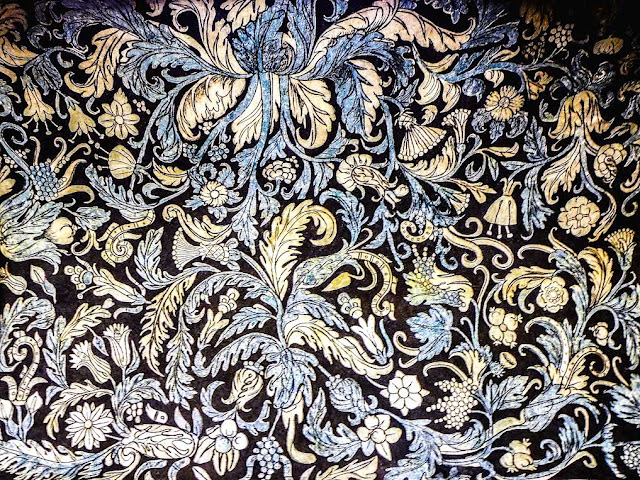Like the portico, the inner faces of the piers at one time bore painted portraits of Augustinian saints and martyrs, of which only two indistinct corner murals —a bishop and a friar—survive. The only other distinctive remnant, in a side niche, is a painting of a friar confronting the Grim Reaper.
Painted in the 1570s and hidden beneath multiple coats of whitewash until the mid-1970s, the famous corridor murals are mostly well preserved, although those on the west side have been partly erased. Recent restoration has imparted a new brilliance to the frescoes that by some accounts may have obscured some of its original subtleties.
The "Garden" murals
The corridor frescoes surround the lower cloister on all four sides, contained within broad, running friezes consisting of bands of foliated decoration.
In traditional Augustinian style, these friezes enclose a long Latin inscription from the Psalm 84, spelled out in ornamental orange letters against a black background:
"My soul yearns, even faints, for the courts of the Lord; my heart and my flesh cry out for the living God. Even the sparrow has found a home, and the swallow a nest for herself, where she may have her young—a place near your altar, Lord Almighty, my King and my God.!
Blessed are those who dwell in your house; they are ever praising you. Blessed are those whose strength is in you, whose hearts are set on pilgrimage.! As they pass through the Valley of Baka, they make it a place of springs;!"
Boldly sketched in warm monochrome, leavened with accents of greenish-gray, the main murals constitute a continuous tapestry or frieze of twisting vines, trees, grasses and flowers featuring native American and Old World flora and fauna—birds, animals and insects—enveloping and linking large, armorial medallions of Augustinian insignia and intricate Christic and Marian monograms, which stand out from the floral background like mystical talismans.
 |
| Adam and Eve in a tree |
Although the design elements are drawn from Islamic and European graphic sources, the execution of the frescoes is indisputedly the work of native artists or tlacuilos, who were skillful observers of the natural world and who, almost fifty years after the conquest, still retained detailed knowledge of pre-hispanic customs and beliefs. In fact, the slotted "song scroll"—the telltale signature of the tlacuilo—appears at intervals in the murals on the vault.
Many of the native plants and animals shown certainly had special meaning for the indigenous viewer. Other significant symbols, perhaps unrecognized, may lurk amid the rich jungle of twisting foliage.
The Cloister Ceilings
Unlike the geometric designs above the portería and upper cloister, the ceilings here complement the wall frescoes, alive with restless, acanthus like foliage with varied blossoms and clusters of grapes. In contrast to the walls, no birds or animals appear although song scrolls are everywhere.
Predominantly painted in blue and orange tones—colors of important prehispanic significance—they are executed in a different hand, evincing a more indigenous approach with heavier outlining of objects and a writhing, almost abstract patterning of the foliage.
Interpretations
Scholarly views of this unique mural program vary. The best known interpretation is that the murals represent and visualize the utopian Paradise Garden. This theme is reinforced by the inclusion of plants and animals that traditionally symbolized sin (serpents and monkeys) and redemption (butterflies and doves), reiterating the medieval monastic view of a civilized and Christian world in constant conflict with untrameled Nature and the disordered domain of the Devil.
Others view the exuberant profusion of native flora and fauna, at least covertly, as a joyous, even musical paean to the prehispanic world of the sacred, recreated in the Christian sphere.
In another view, the frescoes imply the favored Augustinian theme of the Eremitic Life or Thebaida. This subject was rooted in their cenobitic origins and elaborated upon during their later expansion as an apostolic order. It extols the Christian message, conveyed by the friars to bring order and enlightenment to what they viewed as the vast pagan wilderness of the New World.
In any event, the visual superimposition of Christian and Augustinian emblems upon Nature implied that the imposition of such order and enlightenment was possible only through the Augustinian Order, a theme made more explicit in the portería.
The prominent display of Marian emblems embedded in the depictions of luxuriant nature, draws attention to another aspect of 16th century mendicant thought, in which the enclosed cloister also serves to symbolize the Hortus Conclusus, and by extension the inviolate nature of the Virgin Mary herself.
Peterson, Jeanette, The Paradise Garden Murals of Malinalco: Utopia and Empire in Sixteenth-century Mexico, Austin, University of Texas, 1987.
Peterson, Jeanette “La flora y la fauna en los frescos de Malinalco: paraíso convergente”
en Iconología y sociedad. Arte colonial hispanoamericano. XLV Congreso Internacional de Americanistas, México, UNAM-IIE: 23-42 pp. 1987
Estrada de Gerlero, Elena Isabel, “Malinalco. Orígenes de su traza, convento y capillas”, en Malinalco, imágenes de un destino, México, Banca Cremi, 1989
Estrada de Gerlero, Elena Isabel, “Malinalco. Orígenes de su traza, convento y capillas”, en Malinalco, imágenes de un destino, México, Banca Cremi, 1989
RUBIAL GARCÍA, ANTONIO, Hortus eremitarum Las pinturas de tebaidas en los claustros agustinos
Wake, Eleanor, Framing the Sacred University of Oklahoma Press 2010
Wake, Eleanor, Framing the Sacred University of Oklahoma Press 2010
text © 2018 Richard D. Perry. color images courtesy of Robert Jackson and Carolyn Brown













No comments:
Post a Comment